The incline fly is an isolation exercise that targets the chest muscles, specifically the upper chest. The incline angle helps to target the upper portion of the chest and anterior delt and gives a toned look.
This exercise is popular among weightlifters and fitness enthusiasts. It involves lying on an incline bench with dumbbells in hand, sweeping them over the chest, and then lowering them back down.
The Chest Fly is considered the perfect finishing move and is usually performed after big compound lifts, such as the bench press and incline dumbbell press.
There are many variations of incline fly that you can add to your chest workout routine, and each has unique benefits.
- Cable Incline Fly: Cables provide continuous resistance throughout the entire range of motion.
- Dumbbell Incline Fly: Dumbbells allow for a wider range of motion. It enables a deeper stretch and greater muscle activation in the upper chest.
- Single-Arm Incline Fly: Working one side at a time helps address muscle imbalances.
- Machine-Based Incline Fly: Machines offer stability. It lets you focus on muscle engagement without worrying about balance.
- Incline Fly with Bands: Resistance bands provide varying tension—an excellent way to exercise at home.
To Stay Motivated: 150+ Gym Workout Motivational Quotes To Stay Fit
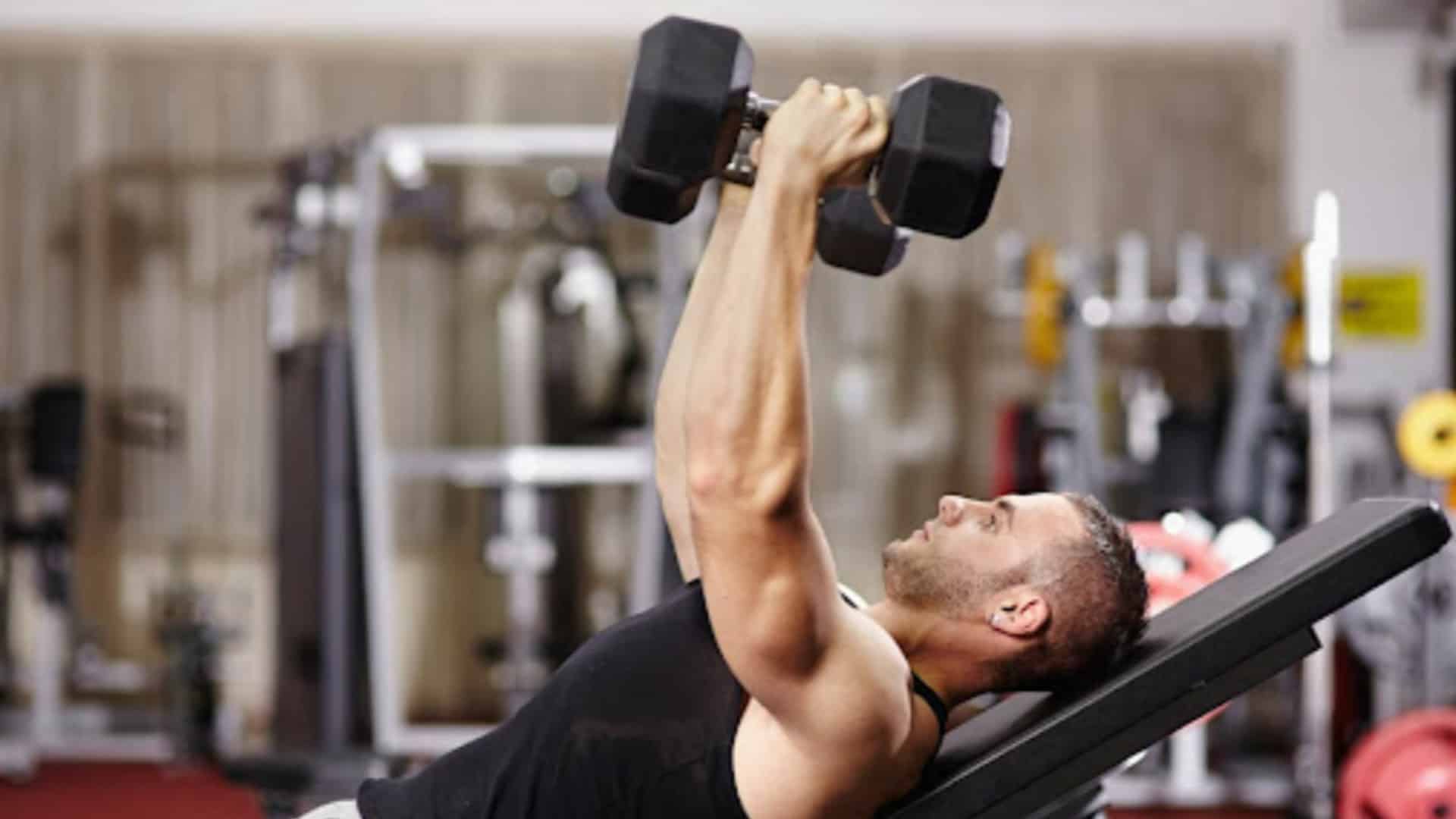
- Incline Chest Flys Muscle Worked
- How To Do Incline Dumbbell Fly
- Tips and Form
- Variations of the Incline Chest Fly
- 1. Incline Cable Chest Fly
- 2. Single Arm Incline Dumbbell Fly
- 3. Incline Dumbbell Twist fly
- 4. Standing Incline Cable Fly
- 5. Incline Fly To Press
- FAQs
- What is the best degree for incline fly?
- What’s the difference between an incline fly and a flat fly?
- Takeaway
- References
Incline Chest Flys Muscle Worked
- The incline chest fly primarily works the upper pectoralis major muscles.
- In addition to its target, the main pec muscle, the incline fly involves several stabilizer and synergist muscles; these muscles include Anterior deltoids and Biceps brachii, Brachialis, Wrist flexors, Obliques, and Rectus abdominis.
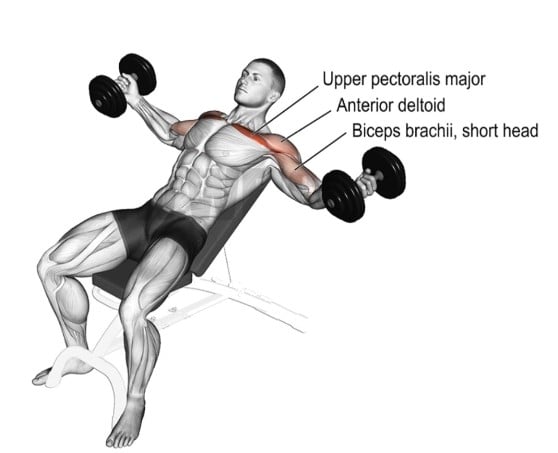
How To Do Incline Dumbbell Fly
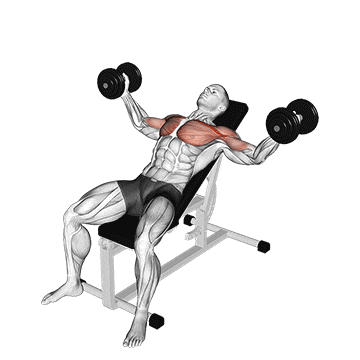
- Adjust an incline bench to a 30-45 degree angle.
- Lie down on the bench with your feet flat on the floor.
- Hold a dumbbell in each hand with your arms extended straight up above your chest.
- Keep your elbows slightly bent and your palms facing each other.
- Slowly lower the dumbbells out to the sides until they are about level with your chest.
- Pause for a second, then press the dumbbell back up to the starting position.
- Do 8-12 Reps and 3-4 Sets.
Tips and Form
- Start with lighter weights and focus on proper form. Too much weight can worsen your form, leading to injuries.
- Keep the weights at chest level or slightly above throughout the exercise. Bringing the weights too low can cause the shoulders to rotate forward, straining the rotator cuff muscles.
- Keep your back neutral. Overaching your back during the exercise can strain the lower back.
- Use slow, controlled movements. Moving the weights up with momentum can distract the focus from the chest muscles and strain other muscles, such as the shoulders and elbow.
- You should do the controlled movement both during the concentric phase (lifting the weights up) and the eccentric phase (lowering the weights back down).
- Avoid touching or banging the dumbbells together during each repetition to maintain constant tension on the intended muscle groups.
Want to take your gains to the next level? Discover your daily calorie needs with our free TDEE calculator
Variations of the Incline Chest Fly
There are several variations of the incline chest fly that you can do to target different areas of your chest muscles.
Some popular variations include the incline dumbbell fly, incline cable fly, and incline machine fly. Try different variations to find out what works best for you.
1. Incline Cable Chest Fly
Incline cable flyes isolate and develop the chest muscles, particularly the upper pectoral region. They also engage the shoulders and triceps for secondary support.
Unlike the incline dumbbell fly, the incline cable fly allows for constant tension, which helps build upper chest fibers.
It helps open up your chest muscles and may also help reduce upper back pain, increase range of motion, and reduce tightness in the upper body.
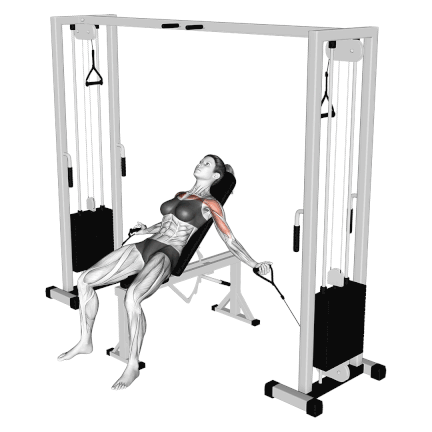
How To Do
- Set both pulleys as low as possible, and position an incline bench in the cable station.
- Set an incline bench at a 30-45-degree angle. Lie on the bench with your feet flat on the floor.
- Grab the handle and lift your arms straight up from your shoulders and hold the cable directly over your upper chest.
- Slowly lower your arms to your sides until your wrists reach about shoulder level or slightly above.
- Bring your arms back toward the midline of your body, focusing on using your pec muscles to draw them back together.
Know More: 14 Best Cable Chest Exercises and Workout Routine
2. Single Arm Incline Dumbbell Fly
The incline dumbbell fly is one of the most popular and widely used variations of the dumbbell fly. It is an isolated strength exercise that targets the upper chest muscle. The Incline dumbbell one-arm chest fly is a unilateral variation of the incline dumbbell fly.
Using one arm at a time allows for greater focus and isolation of the chest muscles. It helps to engage and stimulate the muscle fibers fully.
This exercise is best used on upper hypertrophy days and chest workouts in more traditional bodybuilding splits.

How To Do
- Set an incline bench at 30-45 degrees.
- Lie on an incline bench with a dumbbell in one hand. Extend the dumbbell above your chest.
- Keep your elbow slightly bent, and lower the weight down until it is about chest level.
- Then, slowly bring the dumbbell back up to the starting position.
- Repeat on the other side.
3. Incline Dumbbell Twist fly
The incline dumbbell twist fly provides several benefits over other variations of the chest fly exercise. The twisting motion engages the anterior deltoids and biceps muscles in addition to the chest muscles.
The incline angle and twisting moment target the upper portion of the chest muscles effectively. It helps to make the chest look more defined and sculpted.

How To Do
- Grab a dumbbell with a neutral grip in each hand and lie on an incline bench.
- Hold the weights above you at shoulder height.
- Slightly retract your shoulder blades and unlock your elbows.
- Slowly lower the dumbbells laterally while maintaining the angle at your elbow.
- Once the dumbbells reach chest level, reverse the movement by squeezing your pecs together.
- As the dumbbells return to the starting position, twist the handles so that the bottom of the dumbbells almost touches.
- Start the next repetition by untwisting the handles back to a neutral position. Continue until the set is over.
4. Standing Incline Cable Fly
The standing low to high cable fly, also known as the standing incline cable chest fly, is a unique chest exercise that allows you to isolate the pectoral muscles through a full range of motion. This cable fly variation is a good way to build strength and size in the pecs when you want to work on the upper chest area.
The cable machine allows for smooth and controlled movements, reducing the risk of injury compared to free weights.
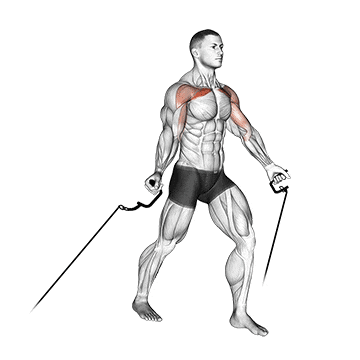
How To Do
- Set both pulleys as low as possible and select the desired weight.
- Grab and hold the handles of overhead pulleys on both sides.
- Bend your elbows and pull your hands toward each other. Pause when your hands touch.
- Slowly lower back to the starting position and repeat.
5. Incline Fly To Press
The incline chest fly-to press is a great alternative for people who feel joint pain while doing the barbell bench press. With proper shoulder-blade stability, the chest fly changes the angle of the movement enough to limit the potential stress on the joints.
It is a variation of the dumbbell fly and Press, or, to be more precise, a combination of the dumbbell fly and incline dumbbell press.
It is a free-weight exercise that primarily targets the upper chest and, to a lesser degree, also targets the biceps, forearms, and triceps.

FAQs
What is the best degree for incline fly?
The best incline angle for targeting the upper chest during incline flyes is usually between 30-45 degrees. This angle effectively targets the upper chest muscles while minimizing strain on the shoulder joints.
What’s the difference between an incline fly and a flat fly?
The primary difference between an incline fly and a flat fly is the bench angle. An incline fly is performed on an inclined bench, targeting the upper chest, whereas a flat fly is performed on a horizontal bench and emphasizes the mid-to lower portion of the chest.
Takeaway
The incline chest fly is generally underrated and often overlooked. However, it is just as important as the bench press to get that well-shaped chest and thickness.
The Inclined chest fly may be a good exercise for building strength in your chest, shoulder, and tricep muscles.
If you’re a beginner, start with a lighter weight and gradually increase the weight each week as you build strength.
References
- Tom Erik Solstad, Vidar Andersen, Matthew Shaw, Erlend Mogstad Hoel, Andreas Vonheim and Atle Hole Saeterbakken: A Comparison of Muscle Activation between Barbell Bench Press and Dumbbell Flyes in Resistance-Trained Males.
- Reiser FC, Lira JLO, Bonfim BMA, Santos Filho SJA, Durante BG, Cardoso JMD, Miotto H, Soares MAA, Bonuzzi GMG, Tavares LD. Electromyography of Dumbbell Fly Exercise Using Different Planes and Labile Surfaces. JEPonline 2017;20(6):31-40
- Behm DG, Leonard, AM, Young WB, Bonsey, WAC, MacKinnon SN. Trunk muscle electromyographic activity with unstable and unilateral exercises. J Strength Cond. Res. 2005, 19, 193–201.

Manish is a NASM-certified fitness and nutrition coach with over 10 years of experience in weight lifting and fat loss fitness coaching. He specializes in gym-based training and has a lot of knowledge about exercise, lifting technique, biomechanics, and more.
Through “Fit Life Regime,” he generously shares the insights he’s gained over a decade in the field. His goal is to equip others with the knowledge to start their own fitness journey.
